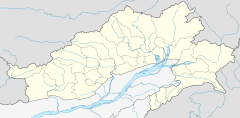| Malinithan | |
|---|---|
 Ruins of Malinithan | |
| Religion | |
| Affiliation | Ethnic religion |
| District | Lower Siang district |
| Deity | Kechai-Khati/Pishasi (tribal goddess)[1] (equivalent to Nang Hoo Toungh)[2] |
| Location | |
| Location | Likabali |
| State | Arunachal Pradesh |
| Country | India |
| Geographic coordinates | 27°39′24″N 94°42′21″E / 27.65667°N 94.70583°E |
| Architecture | |
| Creator | Chutia kings |
| Completed | 13th-14th century |

| Part of a series on the |
| History of Assam |
|---|
 |
| Categories |
Malinithan is an archaeological site containing the ruins of an early medieval period temple on the northern bank of the Brahmaputra River in the Indian state of Arunachal Pradesh. It is assumed to be built by the Chutia kings in the 13th-14th century.[3][4][5][6] Kechai-Khaiti, a tribal goddess found among the Bodo-kachari groups[7][8][9][10][11][12] or the Buddhist goddess Tara[13] is considered to be the chief deity worshipped in the ruined temple. The worship of the goddess Kechaikheiti even after coming under Hindu influence was performed according to her old tribal customs.[14]
The goddess was taken care of by tribal priest known as the Deoris and was worshipped by the Borgoya khel of the Deoris.[15] There were four different kinds of Deori priest who looked after the deity Kechaikhati. The Bar Bharali and the Saru Bharali collected dues of the temple and provides animals for sacrifice. The Bar Deori (Deori Dema) and the Saru Deori (Deori Surba) performs the sacrifice and sung hymns.[16]
Some scholars identify Kesaikhaiti to the Tai Khamti female deity of Nang Hoo Toungh.[17]
- ^ (Shin 2023:71)
- ^ (Laine 2019:17–18)
- ^ Sarma, P.C.A study of the temple architecture of Assam from the Gupta period to the end of the Ahom rule: Chutiya architecture, p. 205
- ^ Choudhury, R.D, Heritage of Architecture of Assam, p.5
- ^ Sengupta, Gautam, Archeology in Northeast India, p.359
- ^ Thakur, A.K, Pre-historic Archeological Remains of Arunachal Pradesh and People's perception: An Overview, p.6
- ^ Kechai Khati worshipped by Bodo-kacharis
- ^ Rabhas worship Kechai-khati and celebrate the Kechai-khati festival once every year
- ^ Kechai-khati festival of Rabhas
- ^ The Tiwas, as well as the Koch, also worshipped Kechai Kati. The Koch general Gohain Kamal built temples dedicated to Kesai Khati in Khaspur for the Dehans who were Tiwa and Mech soldiers from Gobha, Nellie and Kabi.
- ^ "There is at Sadiya a shrine of Kechai Khaiti the tutelar deity of the Kacharis, which the Dimasa rulers continued to worship even after the establishment of their rule in Cachar." (Bhattacharjee 1992:393)
- ^ "The most famous temple of the Chutiyas was that of Kechaikhati, their primodial female deity.(Dutta 1985:49)
- ^ "In her fearsome self this deity bears so many resemblances to the fierce manifestation of Buddhist Tara that many scholars have suggested a Buddhist origin for her"(Gogoi 2011:236)
- ^ "(S)he [Kesai Khati] was incorporated into the Sanskritized cosmos of goddess tradition and as her tribal attributes were so strong to be denounced as non-Brahminical, her worship continued according to old customs."(Gogoi 2011:236)
- ^ (Shin 2023:70–71)
- ^ (Shin 2023:70)
- ^ "Towards the north of the Lohit River is the Nang Hoo Toungh territory. The third phi muang is, as the prefix "nang" (lady) indicates, a female divinity. The territory it is said to protect is more easily identifiable than that of the two-previous phi muangs. Nang Hoo Toungh is known in Assamese as Kesakhati ("person who eats raw meat")."(Laine 2019:17–18)

